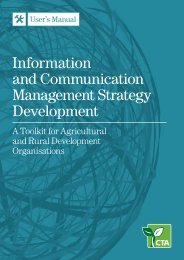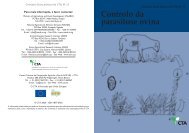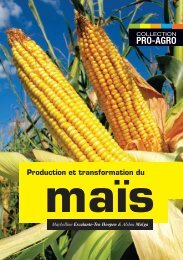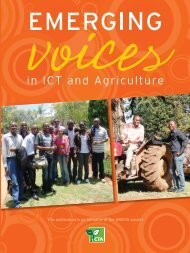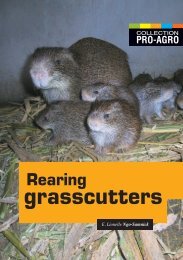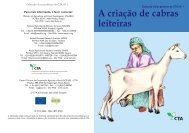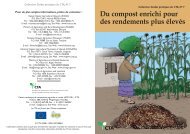Policy framework for Pastoralism in Africa
Policy framework for Pastoralism in Africa
Policy framework for Pastoralism in Africa
- No tags were found...
You also want an ePaper? Increase the reach of your titles
YUMPU automatically turns print PDFs into web optimized ePapers that Google loves.
Under po<strong>in</strong>t (ii) above, it is important that <strong>Africa</strong>n governments and regional organizations recognizethat public <strong>in</strong>vestment <strong>in</strong> pastoral areas is augmented <strong>in</strong> a manner that is at least proportionalto the economic importance of pastoralism. It is to be recalled that M<strong>in</strong>isters <strong>in</strong> charge of Agriculture,Land and Livestock have recommended <strong>for</strong> an allocation of at least 3 per cent of public <strong>in</strong>vestment<strong>for</strong> the livestock sector.Conflict mitigation and management is one of the major issues that prompted the AU pastoralpolicy <strong>in</strong>itiative. Adequate conflict mitigation and management implies:i. Proper identification of sources of conflict, such as depletion or scarcity of resources;ii. Immediate response;iii. Recogniz<strong>in</strong>g and support<strong>in</strong>g traditional conflict management mechanisms;iv. Sensitization work on the prevail<strong>in</strong>g national laws and regulations.Strategy 1.3 Integrat<strong>in</strong>g pastoral issues <strong>in</strong>to decision-mak<strong>in</strong>g processesPastoral development touches on a wide range of issues, notably:i. Equitable access to land, water, capital and technology resources;ii. Equitable access to services, especially education, human and animal health, communicationand f<strong>in</strong>ance;iii. Increas<strong>in</strong>g the value of livestock and preserv<strong>in</strong>g pastoral ecosystems;iv. Market access <strong>for</strong> pastoral products and services;v. Greater participation of pastoral people <strong>in</strong> decision mak<strong>in</strong>g and policy debates;vi. Harness<strong>in</strong>g the collective power of pastoral people and their organizations.Judicious <strong>in</strong>tegration of these issues <strong>in</strong>to national and regional development strategies will be helpfulto br<strong>in</strong>g peace and security to pastoral lands and communities by prevent<strong>in</strong>g conflicts relatedto competition over scarce pastoral resources, and by reduc<strong>in</strong>g the risk of marg<strong>in</strong>alized and frustratedpastoralists pursu<strong>in</strong>g violent means to acquire resources or political <strong>in</strong>fluence. <strong>Policy</strong>-mak<strong>in</strong>gprocesses should promote multidimensional approaches and avoid sector specific paths to policydevelopment; this requires strong coord<strong>in</strong>ation with<strong>in</strong> government.The <strong>in</strong>tegration of pastoral policy with land policy, natural resource management strategies andpoverty reduction programs would be of particular – but not exclusive – importance <strong>in</strong> this regard.Strategy 1.4 Acknowledge the legitimacy of <strong>in</strong>digenous pastoral <strong>in</strong>stitutionsPastoralists are fac<strong>in</strong>g the challenge of adapt<strong>in</strong>g to socio-economic and cultural trans<strong>for</strong>mationsresult<strong>in</strong>g from globalization and emerg<strong>in</strong>g issues such as population pressure, reduced access torangelands, food price and f<strong>in</strong>ancial crises, and other trends. This situation imposes the challengeof blend<strong>in</strong>g tradition and modernity <strong>in</strong> pastoral policy development. In this respect, it calls <strong>for</strong>:i. Recognition by state and local authorities of the important role of traditional pastoral leadershipand structures <strong>in</strong> governance, <strong>in</strong>clud<strong>in</strong>g conflict resolution, management of land tenureand mobility, and facilitation of <strong>in</strong>teractions between pastoralists and other <strong>in</strong>terest groupssuch as crop farmers;ii. The need to address age-old rigidities <strong>in</strong> traditional beliefs and structures, which discrim<strong>in</strong>ateaga<strong>in</strong>st women;iii. Build on and thereby improve <strong>in</strong>digenous rights to pastoral resources of land, pasture and water;34 <strong>Policy</strong> <strong>framework</strong> <strong>for</strong> <strong>Pastoralism</strong> <strong>in</strong> <strong>Africa</strong>




